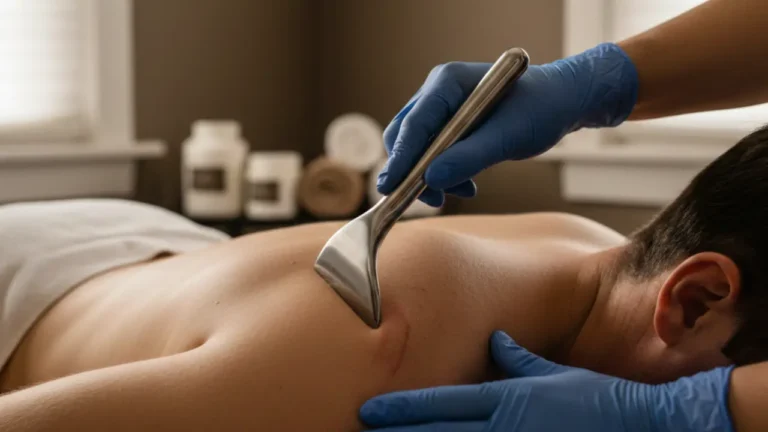6 Times Manual therapy in Langley Helps Reduce Delayed Onset Muscle Soreness (DOMS)
Manual therapy in Langley
What Is Delayed Onset Muscle Soreness (DOMS)?
DOMS, short for Delayed Onset Muscle Soreness, refers to the muscle pain and stiffness that occur after intense or unfamiliar physical activity. Unlike acute injuries, DOMS doesn’t happen immediately it usually sets in within 12 to 24 hours and peaks around 48 hours post-exercise. It often results from eccentric muscle contractions, where muscles lengthen under tension, like when lowering weights or running downhill.
Common symptoms include:
- Tenderness or stiffness in the muscles
- Reduced range of motion
- Temporary muscle weakness
- Swelling or mild inflammation
Though DOMS is generally short-term and self-limiting, it can interfere with physical training, sleep quality, and daily activities.
Why Manual Therapy Matters in DOMS Recovery
While DOMS is part of the muscle adaptation process, its intensity can affect motivation and movement quality. Many gym-goers, athletes, and physically active individuals seek ways to manage these symptoms and return to training without discomfort.
Manual therapy in Langley, a hands-on technique used in physiotherapy, helps ease the discomfort associated with DOMS. It targets soft tissue and joint structures to promote circulation, reduce stiffness, and encourage healing.
Incorporating manual therapy into recovery not only helps reduce the symptoms of DOMS but also supports longer-term movement efficiency and body awareness. This approach is particularly beneficial when soreness begins to hinder performance or daily activity.
How Manual Therapy in Langley Supports DOMS Relief
Manual therapy is versatile and can be tailored to suit each person’s symptoms, training load, and physical goals. It includes a range of methods such as:
- Soft tissue mobilization
- Myofascial release
- Trigger point therapy
- Joint mobilizations
- Passive stretching

Looking to recover faster and get back to doing what you love? At Physio For Performance in Langley, our expert physiotherapists use cutting-edge techniques tailored to your needs.
Don’t wait—book your appointment today and experience a personalized approach to restoring your function and mobility!
These techniques can be applied across different stages of muscle recovery. Let’s look at six key situations where manual therapy in Langley has a direct impact on easing DOMS.
1. After Resistance or Strength Training Sessions
Lifting weights, particularly during eccentric-focused exercises (like slow bicep curls or squats), often causes micro-tears in muscle fibers. This microscopic damage triggers inflammation, leading to soreness and restricted movement.
Manual therapy after such workouts helps by improving blood flow and reducing muscle tightness. A therapist may focus on muscle groups that were heavily used like glutes, hamstrings, or shoulders, to ease tension and improve muscle pliability. This approach promotes quicker nutrient delivery and waste removal, supporting faster recovery.
2. Following High-Intensity Interval Training (HIIT)
HIIT routines often result in DOMS due to their repetitive and explosive nature. Quick changes in movement, like sprinting or jumping, stress the muscles significantly.
Manual therapy in Langley techniques, such as trigger point release or fascia mobilization can reduce localized muscle tightness and help calm the nervous system. By restoring balance in overused muscle groups, individuals can reduce lingering discomfort and maintain consistent training intensity.
3. During Recovery from Plyometric Workouts
Jump-based activities like box jumps, burpees, or jump squats cause high eccentric loading. These movements increase the likelihood of DOMS in areas like calves, quads, and lower back.
Manual therapy in Langley sessions following plyometric workouts focus on easing tension in the lower limbs and core. Therapists often use joint mobilizations and tissue gliding techniques to restore range of motion in joints that may feel restricted after these dynamic exercises.
Improved joint movement reduces compensatory strain and supports healthy biomechanics in future sessions.
4. After Starting a New Exercise Program
Introducing new exercises can surprise the musculoskeletal system. Even if intensity is moderate, unfamiliar movements can trigger soreness as the body adapts.
Manual therapy in Langley supports this adaptation phase by reducing inflammation, enhancing mobility, and calming overactive muscle fibers. Passive stretching and light tissue work are often used to keep the body mobile without adding more stress.
This approach is especially helpful for beginners or those returning from a break, as it provides comfort without hindering progress.
5. When DOMS Disrupts Daily Movement or Sleep
In some cases, DOMS can affect basic movements like bending, walking up stairs, or lifting objects. The discomfort may even impact sleep due to muscle tightness or restlessness.
Manual therapy in Langley helps by calming irritated tissues and restoring mobility in sore muscles. Soft tissue work and myofascial release ease tension while encouraging relaxation. Improved mobility allows for smoother transitions between positions during the day and better rest at night.
By reducing movement limitations, this approach helps individuals return to daily routines more comfortably and confidently.
6. Before Returning to Exercise After a DOMS Episode
Returning to physical activity while DOMS is still present can lead to compensatory movement patterns and increased injury risk. Muscles that feel tight or stiff may alter posture and technique.
Manual therapy prior to resuming exercise helps by preparing the body for motion. Therapists focus on improving joint range and reducing any residual soreness that could affect technique. This ensures a safer and more effective return to training.
Incorporating manual therapy in the pre-exercise phase supports a smoother transition and reduces hesitation caused by lingering discomfort.
Combining Manual Therapy in Langley with Broader Physiotherapy Support
Manual therapy is one tool within a broader physiotherapy framework. A qualified physiotherapist will assess movement patterns, identify postural imbalances, and create a recovery plan that combines manual therapy with guided exercise, education, and self-care strategies.
Key physiotherapy elements that enhance DOMS recovery include:
- Mobility and range-of-motion exercises
- Posture and movement assessments
- Recovery timelines aligned with training plans
- Guidance on hydration, nutrition, and active rest
This well-rounded approach ensures that manual therapy in Langley complements broader movement goals and performance outcomes.
Practical Tips for Managing DOMS Alongside Manual Therapy
To further support recovery, individuals experiencing DOMS can also try:
- Gentle active movement (like walking or low-impact cycling) to encourage circulation
- Hydration and nutrition to support muscle repair
- Foam rolling or self-myofascial release between sessions
- Stretching after workouts to maintain tissue elasticity
When combined with manual therapy, these steps help minimize downtime and promote more efficient muscle recovery.
Moving Forward
Delayed onset muscle soreness may be common, but it doesn’t have to derail your progress or affect daily function. Manual therapy offers a supportive and adaptable approach for easing discomfort, improving mobility, and guiding the body through recovery.
For those incorporating exercise into their routine whether through weightlifting, HIIT, or athletic conditioning manual therapy in Langley can be a valuable component of a comprehensive recovery plan.
At Physio for Performance, manual therapy is integrated into tailored care plans that align with each individual’s movement goals and physical demands. Through professional assessment and targeted techniques, the clinic supports recovery from DOMS while helping clients stay active and consistent in their fitness journey.



